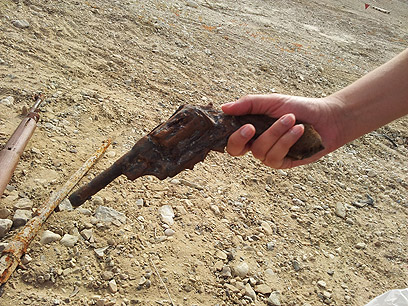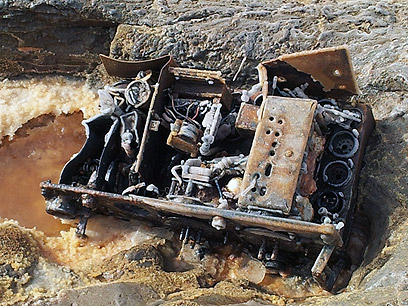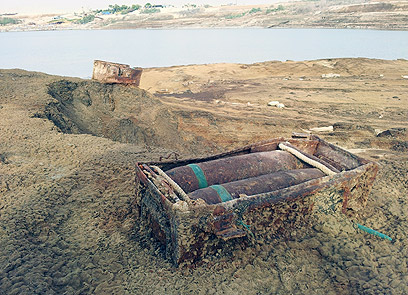Massive weapons’ reservoir believed to belong to German imperial army from WWI discovered in Dead Sea due to receding waterline; preserved in near perfect condition thanks to high salt content
By Yoav Zitun
The IDF‘s Combat Engineering Corps will soon uncover another layer of the ‘ancient German bunker’ which was concealed in the northern Dead Searegion.
The Dead Sea’s receding waterline led to the exposure of a massive weapons’ reservoir with thousands of artillery shells, bullets, rifles, guns, mines, explosives and even ancient walkie-talkies which were preserved in near perfect condition thanks to the high salt content in the water.
A few years ago, tourists on Kalia beach reported a find of suspicious ammunition that was popping up out of the water. The Engineering Corps launched an initial investigation where it was discovered that the weapons did not belong to the IDF.

Near perfect preservation - Photo: Yoav Zitun
Colonel Yaron Beit-On of the Engineering Corps recently completed an investigation into the origins of the weapons and he discovered that they most likely belong to a regiment from the Imperial German army which fought in Israel during WWI alongside the Turks against the British.
“Our inquiries revealed that during that period, a German regiment was stationed in the northern Dead Sea and we believe that after they lost and were forced to return to Europe, they left their weapons behind in the Dead Sea,” Beit-On told Ynet.

Walkie talkie in the Dead Sea - Photo: Yoav Zitun
“They most likely sailed boats into the Dead Sea and flung the shells, rifles and all the rest of the weapons into the sea at equal distances in a uniform manner.
“We were astounded by the quality of the weapons preserved in the sea, thanks to the salt.” According to Beit-On, the receding waterline and the weapons exposure to air caused corrosion and thick layers of salt to develop on the weapons.
Central Command discovered that the shells and mines were still in good enough condition to explode and endanger lives, though the area is already a closed military zone which is mined and closed off to civilians: Between the border fence and the border with Jordan at the northern most point of the Dead Sea.
“Right there is a mine that’s ready to explode,” Beit-On’s deputy Lieutenant Colonel Hezi Revivo warned. “The waterline has receded by dozens of meters and at first we were assisted by the underwater ops unit to blow up the ammunition under water.

Explosives popped up - Photo: Yoav Zitun
“At first we thought it was Jordanian weapons left here since the Six Day War but the moment we saw it was organized in lines we realized that whoever had done this did so in an organized fashion.
Some of the weapons, German Mauser rifles of the kind used by the IDF in the 50s, had a stamp stating they were manufactured in 1895, which strengthened the hypothesis that they were used here in WWI.”
Central Command took a small number of pieces as souvenirs, including a rifle and gun which were cleaned, but the rest were blown up or sent for destruction.
“We may send pictures of the weapons stash to the German military attaché in Israel to confirm our hypothesis,” Beit-On noted.
View original Ynet publication at: http://www.ynetnews.com/articles/0,7340,L-4240978,00.html







 Israeli New Shekel Exchange Rate
Israeli New Shekel Exchange Rate